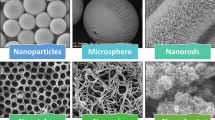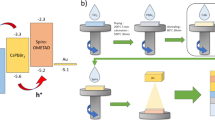Abstract
Mercury bismuth sulfide (HgBi2S3), a member of the II–V–VI group of semiconducting materials, has not been previously synthesized, investigated, or reported as a potential absorber layer for solar cells. This ternary metal chalcogen exhibits an optical energy band gap ranging from 1.4 to 1.7 eV, demonstrating efficient absorption in the range of 104 to 105 cm−1. In this study, thin films of titanium dioxide (TiO2) and HgBi2S3 were synthesized and deposited using spin coating and chemical bath deposition methods, respectively as a function of deposition time. The synthesized TiO2/HgBi2S3 thin film was subjected to characterization techniques including X-ray diffraction (XRD), UV–Visible spectroscopy, scanning electron microscopy (SEM), energy dispersive X-ray (EDXS) spectroscopic analysis, electrochemical impedance spectroscopy (EIS) and photoelectrochemical performance (JV) evaluation. XRD analysis confirmed the deposition of a polycrystalline thin film with an average crystalline size ranging from 401 to 789 nm, depending on the deposition time of 60 to 180 min.The average particle size of the film varied from 218 to 479 nm, and the thickness of the TiO2/HgBi2S3 thin film was measured to be between 10.14 and 12.47 μm. After sensitization, the contact angle of the TiO2 thin film decreased from 400 to 180, and this change was independent of the deposition time of the HgBi2S3 thin film. The absorbance of the TiO2 thin film showed an increasing trend with deposition time, while the optical energy gap of TiO2 decreased from 3.12 to 1.54 eV following the deposition of the HgBi2S3 thin film. EDXS analysis confirmed the successful deposition of HgBi2S3 onto the TiO2 thin film. However, the HgBi2S3 sensitized TiO2 thin film exhibited only marginal photovoltaic performance with maximum short circuit current of 0.3537 mA/cm2 for deposition time of 60 min.












Similar content being viewed by others
Data and code availability
The data that support the findings of this study are available from the corresponding author, [SAP], upon reasonable request.
References
L. Frass, L. Partain, Solar cells and their applications, 2nd edn. (John Wiley & Sons Inc., Hoboken, NJ, 2010)
B. O’Regan, M. Grätzel, A Nature 353, 737 (1991)
Poortmans, J., & Arkhipov, V. Thin Film Solar Cells - Fabrication, Characterization and Application. (Wiley Series in Materials for Electronic and Optoelectronic Applications, England 2006)
N.G. Park, K.M. Kim, M.G. Kang, K.S. Ryu, S.H. Chang, Y. Shin, J Advanced Materials 17, 2349 (2005)
M.J. Jeng, Y.L. Wung, L.B. Chang, L. Chow, International Journal of Photoenergy Article ID 563897, 1 (2013)
J.E. Ikpesu, S.E. Iyuke, M. Daramola, A.O. Okewale, Sol. Energy 206, 918 (2020)
R.S. Mane, C.D. Lokhande, Mater. Chem. Phys. 65, 1 (2000)
C. Coughlan, M. Ibáñez, O. Dobrozhan, A. Singh, A. Cabot, & Ryan. K Chemical Reviews 117, 5865 (2017)
N. Pai, J. Lu, D.C. Senevirathna, S.J. Anthony, Materials Chemistry C 6, 2483 (2018)
Zhou, S., Yang, J., Li, Z. W., Jiang, Q., Luo, Y., Zhang, D., et al. Journal of the Electrochemical Society, 163 (2016)
P.C. Huang, W.C. Yang, M.W. Lee, J. Phys. Chem. Lett. 17, 18308 (2013)
S. Xu, N. Cheng, H. Yin, D. Cao, & Mi. B Chemical Engineering Journal 397, 125463 (2020)
N.S. Samsi, N.A.S. Effendi, R. Zakaria, A.M.M. Ali, Materials Research Express 4, 044005 (2017)
L. Yingpin, W. Yanan, F. Kangning, H. Yanzhong, P. Pei, J.S. Bao, Materials Research Express 5, 065903 (2018)
J. Yang, J.Y. Kim, J.H. Yu, T.Y. Ahn, H. Lee, T.S. Choi et al., Phys. Chem. Chem. Phys. 15, 20517 (2013)
W.S. Brower, H.S. Parker, R. Roth, S Materials Research Bulletin 8, 859 (1973)
A.U. Ubale, S.C. Shirbhate, J. Alloy. Compd. 497, 228 (2010)
M.E. Rincón, M. Sánchez, P.J. George, A. Sánchez, P.K. Nair, J. Solid State Chem. 136, 167 (1998)
R.A. Wagh, A.N. Kulkarni, P.K. Baviskar, Mater. Renewable Sustainable Energy 7, 13 (2018)
M. Barthaburu, I.G. Pérez, I. Aguiar, H. Bentos Pereira, L.P. Bethencourt et al., Nano-Structures & Nano-Objects 10, 15 (2017)
X. Xu, E.R. Carraway, Nanomaterials and Nanotechnology 2, 17 (2012)
R.S. Patil, C.D. Lokhande, R.S. Mane, H.M. Pathan, O.S. Joo, S.H. Han, Mater. Sci. Eng. B 129, 59 (2006)
E. Pineda, M.E. Nicho, P.K. Nair, H. Hu, Sol. Energy 86, 1017 (2012)
H.C. Liao, M.C. Wu, M.H. Jao, C.M. Chuang, Y.F. Chen, W.F. Su, Cryst Eng Comm 14, 3645 (2012)
P.R. Nikam, P.K. Baviskar, J.V. Sali, K.V. Gurav, J.H. Kim, B.R. Sankapal, Ceram. Int. 41, 10394 (2015)
J. Arumugam, A. George, A.D. Raj, A.A. Irudayaraj, R.L. Josephine, S.J. Sundaram et al., J. Alloy. Compd. 863, 158681 (2021)
R.P. Usha, R. Oommen, C. Sanjeeviraja, Chalcogenide Letters 8, 683 (2011)
Cullity, B. D. Elements of X-ray diffraction 2nd ed. (Addison-Wesley Publishing Company USA 1978)
M. Khakzad, M. Pourfarzad, S.M. Sadrnezhaad, Mater. Sci. Eng. B 222, 11 (2016)
Y. Tachibana, J.E. Moser, M. Grätzel, D.R. Klug, J.R. Durrant, J. Phys. Chem. B 100, 20056 (1996)
X. Li, Y. Sun, H. Zhang, X. Wang, Mater. Sci. Eng. B 248, 103 (2018)
S. Jiang, Y. Chen, B. Li, J. Wang, Journal of Materials Chemistry A 5, 17736 (2017)
R.G. Pearson, Journal of the Chemical Society. Chem. Commun. 83, 269 (1983)
Z. Chen, Y. Zhang, J. Liu, H. Zhang, Journal of Materials Chemistry A 6, 12035 (2018)
J. Tauc, Optical absorption of semiconductors. Solid State Physics 17, 1–102 (1965)
H. Li, L. Ma, S. Jiang, J. Chen, ACS Appl. Mater. Interfaces 9, 34657 (2017)
Q. Wang, J.E. Moser, M. Grätzel, J. Phys. Chem. B 109, 14945 (2005)
A.J. Bard, L.R. Faulkner, Electrochemical methods: Fundamentals and applications (Wiley, New York, 2001), pp.523–524
Wang, H., Chen, X., & Liu, J. Electrochemical impedance spectroscopy for characterization of dye-sensitized solar cells. In Electrochemical impedance spectroscopy: Theory and application (Springer, Cham, 2016) 195–219
S. Majumder, N. Mansor, T.S. Miller, I. Dedigama, A.B. Jorge, P.F. McMillan, Z. Chen, Electrochim. Acta 222, 100 (2016)
M.A. Green, Third generation photovoltaics: Advanced solar cells (Imperial College Press, London, 2002), pp.161–162
Acknowledgements
The authors sincerely acknowledge the Kaviyatri Bahinabai Chaudhari North Maharashtra University Jalgaon, Department of Physics PSGVP Mandal’s Arts, Commerce & Science College Shahada, Nandurbar, Advanced Physics Lab-Department of Physics, Savitribai Phule University Pune, Baburaoji Gholap Science College Pune and Icon Analytical New Mumbai for pro- viding characterization facilities.
Funding
The authors did not receive support from any organization for the submitted work.
Author information
Authors and Affiliations
Contributions
Conceptualization: Sachin Padwal, Dr Rahul Wagh, Dr Jivan Thakare, Dr Rajendra Patil; Methodology: Sachin Padwal; Formal analysis and investigation: Sachin Padwal, Dr Rahul Wagh; Writing—original draft preparation: Sachin Padwal; Writing—review and editing: Sachin Padwal, Dr Rahul Wagh, Dr Jivan Thakare; Funding acquisition: Not applicable; Resources: Sachin Padwal; Supervision: Dr Rahul Wagh, Dr Jivan Thakare, Dr Rajendra Patil.
Corresponding author
Ethics declarations
Conflict of interest
The authors have no conflict of interest to declare. Also, the authors have no known competing financial interests or personal relationship that could have appeared to influence the work reported in this paper.
Ethical approval
Not applicable.
Additional information
Publisher's Note
Springer Nature remains neutral with regard to jurisdictional claims in published maps and institutional affiliations.
Rights and permissions
Springer Nature or its licensor (e.g. a society or other partner) holds exclusive rights to this article under a publishing agreement with the author(s) or other rightsholder(s); author self-archiving of the accepted manuscript version of this article is solely governed by the terms of such publishing agreement and applicable law.
About this article
Cite this article
Padwal, S., Wagh, R., Thakare, J. et al. Chemical bath deposition of mercury bismuth sulfide (HgBi2S3) sensitized titanium dioxide (TiO2) thin films: An In-depth analysis and characterization study. Appl. Phys. A 130, 34 (2024). https://doi.org/10.1007/s00339-023-07202-y
Received:
Accepted:
Published:
DOI: https://doi.org/10.1007/s00339-023-07202-y




